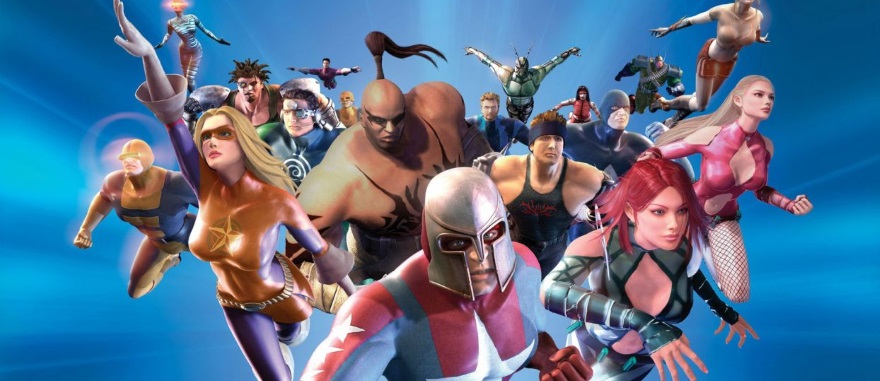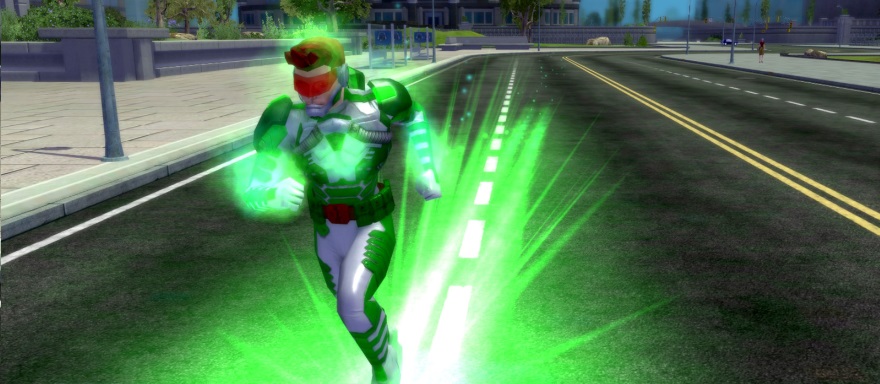
For the longest time in the early 2000s, MMORPGs scared me off. They looked too obtuse, too grindy, too ugly, and too unapproachable for my tastes. It took a special title to really draw me in with its more casual friendly structure and colorful graphics. In early 2004, I found myself entranced with this superhero MMO that let me be whatever type of caped (or non-caped) crusader I wanted to be. From then on, there was no going back with my interest in these types of games.
I assume that many MMO gamers owe a great debt to City of Heroes for the way that it introduced, encouraged, and excited them about MMOs. It was a new type of online game, one that boasted an unbelievably flexible character creator and invested in the fantasy of playing as a superhero fighting villains all across Paragon City.
Today we’re going to kick off a Game Archaeologist series looking back at City of Heroes. And as with any remarkable superhero, we have to begin with its origin story. Where did it come from? How was it made? Let’s find out!

A Cryptic announcement
It was 1999. Amid the boom of MMORPGs that saw the rise of titles such as Ultima Online and EverQuest, many studios were shifting their attention to the potential of this genre. Even more, other studios were starting up with the hopes of getting their piece of the pie. Among the hopeful were two childhood friends named Michael Lewis and Rick Dakan.
Lewis was a long-time Dungeons & Dragons fan who held a degree in computer systems engineering and ran a graphics chip company in the mid-90s that was acquired by Broadcom in 1999 for $60 million. He walked away from the company with $17 million and was approached by his longtime friend Dakan about the idea of creating an online game about superheroes.
“We’d been role-playing gamers growing up, and thought that online would be a great way to continue that experience,” Lewis said in 2007. “We decided that there were too many fantasy games in development — this was 1999, so we discussed many alternatives. Superheroes quickly rose to the top of the list. It is something people could understand and identify with quickly, versus ideas like science fiction or horror, because it provides an infinite background on which to create adventures of all kinds. And who doesn’t want to have super powers?”
Lewis also bumped into former Atari engineer Bruce Rogers, who was creating his own graphics engine, and recruited him for the project. Another employee was added early on named Jack Emmert, who at the time was teaching classics at Ohio State but soon became the MMO’s lead developer. With this core team in place, Cryptic Studios was born in summer 2000.

Suiting up
Ideas were one thing, money to make it happen was another. Lewis invested $2.5 million of his own money into Cryptic’s superhero project, and the studio secured $4.5 million more in loans from NCsoft. This would actually be pretty cheap in comparison to operating costs, which leaped to $18 million per year when the game went live.
Early on, the team decided that it was too expensive and somewhat unnecessary to obtain official IP licenses from Marvel or DC. Instead, it elected to make up its own unique IP that included well-known superhero themes, tropes, and powers. “Nobody really cares about the name, they just want to put on a suit and fight evil,” said Emmert in a later interview.
On September 26th, 2001, Cryptic Studios superjumped into the gaming consciousness by officially unveiling its upcoming online RPG, City of Heroes. Only the broadest of feature definitions and a handful of screenshots accompanied this announcement, but it was enough to get the attention of players and the media.
The originally stated goal was to get City of Heroes out in mid-2002, but as we all know, those initial timeline assessments never pan out. By early 2002, Cryptic cozied up to NCsoft even further by signing a loan and distribution agreement with the megapublisher.
Even with this to boost the project’s legitimacy, City of Heroes fell behind in its development and was frustrating its team and publisher with what was described as “ineffective code and joyless, fussy play.”
At that point, Lewis realized that he needed to take a much more firm hand in the game’s development. He directed the team to make the game simpler, combating the creeping complexity that plagued a lot of MMOs. Lewis also fired Dakan from the studio and tasked him to work on a City of Heroes comic book.

Ripped from the comic pages
Meanwhile, fans were growing increasingly excited about City of Heroes. NCsoft footed the bill for an exciting trailer to show off in 2003. It was a big hit at E3, winning the Best Online Multiplayer award and the Best Online Game award. All of this no doubt helped its rising popularity.
As a fun promotional contest leading up to the launch, NCsoft ran a competition to design a special superhero for the game. The winner of the contest created Numina, a ghostly being of pure psychic energy.
Cryptic talked up the game world as a “living city” with reactive NPCs, a deep character creator, and a setting that would offer far more variety and interest than standard fantasy MMOs. The basic premise of the game is that America’s largest and greatest city had been crippled by alien attacks and an influx of supervillains, and a call had been sent out to superheroes to come help restore order and promote justice.
The devs said that they didn’t want to adhere to any specific time period or comic book era for the MMO: “We all agreed, however, that the game should feel as ‘modern’ as possible. In other words, our heroes and villains will resemble those that you might encounter in today’s comics rather than ones you’d see in the ’40s or ’60s.”
The studio’s growing team of (eventually) 35 members crafted the initial MMO out of 480,000 lines of code, 25,000 graphics files, 400 different powers, and 30,000 enemy NPCs. Each of the game’s multiple servers were slated to handle between 2,000 to 3,000 players at a time. The balance of the game was struck at 75% fighting bad guys and 25% helping people and talking with NPCs.
Beta testing on City of Heroes commenced in January 2004. By April, more than 30,000 players were putting the game through its paces and helping the dev team to shore up its weaknesses and fix the biggest problems. Those who had pre-ordered the game were able to reserve their names shortly before launch, kicking off a long-running series of goofy and punny pseudonyms that would dominate the game’s history.
Finally, City of Heroes was ready to fly, and on April 27th, 2004, players entered Paragon City on the live servers, paying $15 a month for the privilege.
Next time on The Game Archaeologist
We’ll look at the launch, reception, and early years of City of Heroes that led up to its first expansion — and a disturbing lawsuit that threatened to tank the game.
Here’s the whole saga to date!
 The Game Archaeologist: Digging up the history of City of Heroes
The Game Archaeologist: Digging up the history of City of Heroes
 The Game Archaeologist: City of Heroes’ launch history and the Marvel lawsuit
The Game Archaeologist: City of Heroes’ launch history and the Marvel lawsuit
 The Game Archaeologist: City of Villains, enhancement diversification, and Going Rogue
The Game Archaeologist: City of Villains, enhancement diversification, and Going Rogue
 The Game Archaeologist: City of Heroes moves into the Paragon Studios era
The Game Archaeologist: City of Heroes moves into the Paragon Studios era
 The Game Archaeologist: The Death of City of Heroes
The Game Archaeologist: The Death of City of Heroes
 Believe it or not, MMOs did exist prior to World of Warcraft! Every two weeks, The Game Archaeologist looks back at classic online games and their history to learn a thing or two about where the industry came from… and where it might be heading.
Believe it or not, MMOs did exist prior to World of Warcraft! Every two weeks, The Game Archaeologist looks back at classic online games and their history to learn a thing or two about where the industry came from… and where it might be heading.













